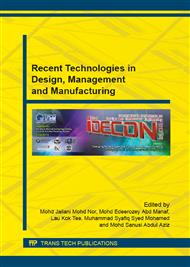[1]
M. Brownsword, A Pragmatic Integration of Risk Management Processes, 4th IET International Conference on System Safety, pp.1-5, Oct (2009).
DOI: 10.1049/cp.2009.1552
Google Scholar
[2]
T.C. Papadopoulou, M. Ozbayrak, Leanness: experiences from the journey to date, J. Manuf. Technol. Manage. 167 (2005) 784-807.
Google Scholar
[3]
B. Kollberg, J.J. Dahlgaard, P. Brehmer, Measuring lean initiatives in healthcare care services: issues and findings, International J. Productivity Perform. Manage. 561 (2007) 7-24.
DOI: 10.1108/17410400710717064
Google Scholar
[4]
J.P. Womack, D.T. Jones, Lean Thinking, Simon & Schuster, London, (2003).
Google Scholar
[5]
S. Gang, Q. Shi, The Application of Lean Thinking in Transition of Manufacturing Services, 2nd International Conference Multimedia and Information Technology, pp.48-51, Dec (2010).
DOI: 10.1109/mmit.2010.52
Google Scholar
[6]
J. Womack, Moving beyond the tool age - The development of lean thinking over the past 15 years has often been labelled the tool age, but to make lean deliver its full benefits companies must move beyond that into the age of lean management, IET Manuf. Eng. 86 (2007).
DOI: 10.1049/me:20070101
Google Scholar
[7]
G. Schuh, M. Lenders, S. Hieber, Lean Innovation: Introducing Value Systems to Product Development, Portland Iernational Center for Management of Engineering and Technology, pp.1129-1136, Jul (2008).
DOI: 10.1109/picmet.2008.4599723
Google Scholar
[8]
A.P. Puvanasvaran, M.H.M.A. Megat, S.H. Tang, M.R. Muhamad, A.M.S. Hamouda, A review of problem solving capabilities in lean process management, Am. J. Appl. Sci. 55 (2008) 504-511.
DOI: 10.3844/ajassp.2008.504.511
Google Scholar
[9]
L.S. Pheng, Q.T. Chuan, Environmental factors and work performance of project managers in the construction industry, Int. J. Project Manage. 241 (2006) 24-37.
DOI: 10.1016/j.ijproman.2005.06.001
Google Scholar
[10]
K.B. Ratsiepe, R. Yazdanifard, Poor Risk Management as One of the Major Reasons Causing Failure of Project Management, International Conference on Management and Service Science (MASS), pp.1-5, Aug (2011).
DOI: 10.1109/icmss.2011.5999104
Google Scholar
[11]
R. Williams, B. Bertsch, B. Dale, T. van der Wiele, J. van Iwaarden, M. Smith, R. Visser, Quality and risk management: what are the key issues?, The TQM Mag. 18 (2006) 67-86.
DOI: 10.1108/09544780610637703
Google Scholar
[12]
H.J. Thamhain, The Human Side of Managing Risks in R&D Projects, IEEE International Engineering Management Conference, pp.591-595, Oct (2004).
Google Scholar
[13]
N. I . Anuar, P.K. Ng, The Role of Time, Cost and Quality in Project Management, IEEE Industrial Engineering and Engineering Management (IEEM), pp.630-634, Dec (2011).
DOI: 10.1109/ieem.2011.6117993
Google Scholar
[14]
P.K. Ng, N. I. Anuar, A Case Study on the Importance of Knowledge Management in Creative Product Development", Industrial Engineering and Engineering Management (IEEM), IEEE International Conreference, pp.669-673, Dec (2011).
DOI: 10.1109/ieem.2011.6118001
Google Scholar
[15]
A.P. Puvanasvaran, S.T. Kerk, M.R. Muhamad, Principles and Business Improvement Initiatives of Lean Relates to Environmental Management System,. IEEE International Technology Management Conference, pp.439-444, Jun (2011).
DOI: 10.1109/itmc.2011.5996010
Google Scholar
[16]
D. Sarkar, Lean for service organisations and offices: A Holistic Approach for Achieving Operational Excellence and Improvement, ASQ Quality Press Milwaukee, Wisconsin, (2007).
Google Scholar
[17]
T.M. Skelton, H.J. Thamhain, The Human Side of Making Risks in High-Tech Product Developments, IEEE Engineering Management Conference (IEMC), pp.600-604, Nov (2003).
DOI: 10.1109/iemc.2003.1252344
Google Scholar
[18]
J. Liebowitz, Key ingredients to the success of an organization's knowledge management strategy, Knowledge and Process Management. 61 (1999) 37–40.
DOI: 10.1002/(sici)1099-1441(199903)6:1<37::aid-kpm40>3.0.co;2-m
Google Scholar
[19]
Z. Li, J. Ye, Y. Zou, An Empirical Study on the Effect Mechanism of Knowledge Management on New Product Development in Aviation Industry, International Conference on Wireless Communications, Networking and Mobile Computing, pp.5460-5461, Sep (2007).
DOI: 10.1109/wicom.2007.1337
Google Scholar
[20]
P.K. Ng, G.G.G. Goh, U.C. Eze, Knowledge Management: A Case study of KM's role in a semiconductor manufacturing firm, International Conference on Quality, Productivity and Performance Measurement, pp.1-8, Nov (2009).
Google Scholar
[21]
P.K. Ng, K.S. Jee, N.I. Anuar, The Role Of Cross-Functional Teamwork in Developing Creativity: A Review, 3rd International Conference on Engineering and ICT, pp.43-47, Apr (2012).
Google Scholar
[22]
G.K. Kanji, Leadership is prime: How do you measure leadership excellence, Total Quality Management & Business Excellence. 194 (2008) 417-427.
DOI: 10.1080/14783360802002834
Google Scholar
[23]
D.L. Goetsch, S.B. Davis, Quality Management: Introduction to Total Quality Management for Production, Processing, and Services, Pearson Education International, New Jersey, (2006).
Google Scholar
[24]
C. Lakshman, A Theory of Leadership for Quality: Lessons from TQM for Leadership Theory, Total Quality Management & Business Excellence. 171 (2006) 41-60.
DOI: 10.1080/14783360500249729
Google Scholar
[25]
H. Kaynak, The relationship between total quality management practices and their effects on firm performance, J. Oper. Manage. 214 (2003) 405-435.
DOI: 10.1016/s0272-6963(03)00004-4
Google Scholar
[26]
F. Fuentes, M. Mar, F.L.M. Javier, M.F. Luis, Total quality management, strategic orientation and organizational performance: The case of Spanish companies, Total Quality Management & Business Excellence. 173 (2006) 303-323.
DOI: 10.1080/14783360500451358
Google Scholar
[27]
Y.S. Ma, G. Chen, G. Thimm, Paradigm shift: unified and associative feature-based concurrent and collaborative engineering, J. Intel. Manuf. 196 (2008) 625-641.
DOI: 10.1007/s10845-008-0128-y
Google Scholar
[28]
P.K. Ng, K.S. Jee, Creative knowledge sharing for superior product development: A case study, J. Knowl. Manage. Pract. 12 (2011).
Google Scholar


